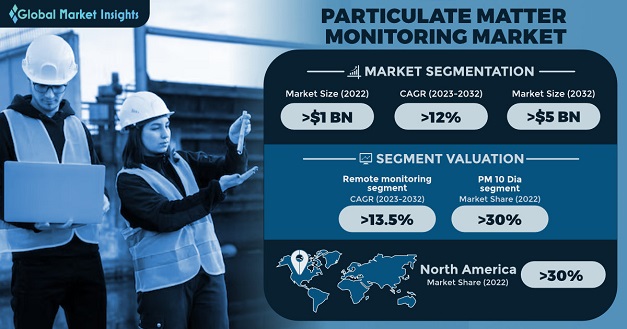Home > Semiconductors & Electronics > Sensors > Particulate Matter Monitoring Market
Particulate Matter Monitoring Market Size
- Report ID: GMI7112
- Published Date: Oct 2023
- Report Format: PDF
Particulate Matter Monitoring Market Size
Particulate Matter Monitoring Market was valued at over USD 1 billion in 2022 and is anticipated to grow at a CAGR of over 12% between 2023 and 2032. The increasing government laws and standards for air quality monitoring are driving the particulate matter monitoring industry growth.
Stringent regulations require industries to monitor and reduce PM emissions to safeguard public health and the environment. The compliance with these standards necessitates the adoption of advanced PM monitoring systems. As governments worldwide have imposed stricter air quality requirements, industries are investing in reliable monitoring solutions to meet these standards. The growing demand for PM monitoring technology is propelling market expansion with companies developing innovative sensors & systems to aid in pollution control and ensure adherence to air quality regulations. For instance, in September 2022, The United Nations General Assembly declared that access to clean air and a healthy environment is a universal human right.
PM monitoring refers to the process of measuring and analyzing airborne particles or particulates suspended in the atmosphere. These particles can vary in size and composition and include dust, soot, and various pollutants. PM monitoring systems use specialized sensors and instruments to assess the concentration, composition, and distribution of these particles in the air.
| Report Attribute | Details |
|---|---|
| Base Year: | 2022 |
| Particulate Matter Monitoring Market Size in 2022: | USD 1 Billion |
| Forecast Period: | 2023 to 2032 |
| Forecast Period 2023 to 2032 CAGR: | 12% |
| 2032 Value Projection: | USD 5 Billion |
| Historical Data for: | 2018 - 2022 |
| No. of Pages: | 220 |
| Tables, Charts & Figures: | 347 |
| Segments covered: | Monitoring type, particle size, application, and end-use Industry & region |
| Growth Drivers: |
|
| Pitfalls & Challenges: |
|
The diverse environmental conditions across monitoring locations require specialized equipment, which makes the selection of devices complex. Ensuring precise calibration and consistent data accuracy demands expertise & resources. Maintaining continuous, reliable operations, especially in remote or harsh environments, necessitates frequent maintenance and quality control. The data management and interpretation can be complex, which demands skilled personnel. These challenges in installation, maintenance, and operations can pose hurdles for organizations seeking to establish and sustain effective PM monitoring systems, potentially limiting the growth & effectiveness of the particulate matter monitoring industry.

